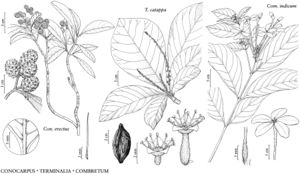Conocarpus
Sp. Pl. 1: 176. 1753.
| Taxon | Illustrator ⠉ | |
|---|---|---|
 | Conocarpus erectus Terminalia catappa Combretum indicum |
Shrubs or trees, dioecious, without pneumatophores. Stems erect or prostrate, equal; twigs glabrous or hairy, hairs appressed to spreading, short-to-elongate, combretaceous. Leaves persistent, alternate and spiral; stipules absent; petiole not differentiated proximally and no part of it persistent, nectar glands glands conspicuous to inconspicuous, at junction of petiole and blade base; blade leathery, venation brochidodromous, apex often acuminate to acute, occasionally obtuse, rarely rounded-mucronate; pit-domatia conspicuous, at junction of abaxial veins with midvein. Inflorescences terminal and axillary, racemes or panicles of spherical or oblong heads, sometimes lateral ones reduced to single head; bracteoles absent. Flowers inconspicuous, each in axil of a bract, unisexual (staminate and pistillate on different plants); hypanthium shallowly cupulate, 0.3–0.5 mm, from constriction at apex of ovary, pubescent abaxially, often densely so; sepals 5, green to pale green, sometimes red-tinged, triangular, glabrate to pubescent abaxially; petals 0; stamens 5–10, long-exserted, with well-developed staminodia; nectary disc atop ovary, pubescent; ovary clearly flattened; style straight to slightly curved, free from hypanthium, with well-developed pistillode; ovules 2. Drupes somewhat flattened, ellipsoid to shortly obovoid, ridged or winged; ridges 2, forming shortly developed wings, slightly convex abaxially, concave adaxially; hypanthium and calyx persistent; fruits densely clustered in conelike heads, fragmenting in age.
Distribution
s United States, Mexico, West Indies, South America, sw Asia (Arabian Peninsula), w, ne Africa, tropical and subtropical areas
Discussion
Species 2 (1 in the flora).
Conocarpus occurs from Florida and extreme southern Texas through the West Indies to Mexico and coastal South America (to northern Peru on the Pacific Coast and to about the Tropic of Capricorn on the Atlantic Coast), and also in coastal western tropical Africa, northeastern Africa, and the Arabian Peninsula.
Selected References
None.